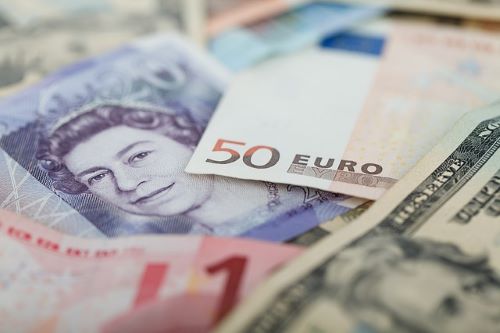Where does an exchange rate come from?
At its core, an exchange rate is a representation of the supply and demand between two currencies. The number fluctuates as the demand relationship between a given pair of currencies shifts throughout the day.
The foreign exchange of currency happens on the forex market. The forex market is composed of banks, commercial companies, central banks, investment management firms, hedge funds, and retail forex brokers and investors, according to Investopedia.
The forex market is not a physical place, but the traders who execute these trades are gathered in financial hubs like New York, Hong Kong and London. The largest currency traders in the world are banks like JPMorgan, Deutsche Bank and Citi.
The reason exchange rates shift so much, is because currencies are traded in massive volumes everyday. This is the biggest market in daily trading volume with $5 trillion traded per day in 2016. This also makes the forex the most liquid in the world. It is open 24 hours a day, 5 days a week.
You can purchase foreign currencies just like a stock or bond. Individual investors are able to trade currency on the forex market but it’s hard to predict the moves in the market when a single move by a giant bank can cause demand to plummet or soar.
The reason that these trades happen in such large volumes everyday is because countries need the right currency before they can trade. Just like when an American tourist visits England, they need a British Pound before they transact with a British company. This same process happens between nations, trading different forms of currency before they actually transact.
The United States Dollar (USD) is the reserve currency for the entire world. Our money underpins the entire global financial system. What happens to the USD affects the planet. Consequently, other nations may to keep reserves of USD on hand to combat inflation of their own currency.
The Majors
These few exchange pairs are the most liquid currencies that make of the majority of activity on the exchange. These pairs are known as the majors, listed here in no specific order:
USD – Euro (most traded)
USD – Great British Pound
USD – Swiss Franc
USD – Japanese Yen
USD – New Zealand Dollar
USD- Australian Dollar
USD – Canadian Dollar
Obviously, the U.S. Dollar is the common factor in all these trading pairs. As if it wasn’t clear enough, the USD is central not just to our economy, but for the entire globe.
Relevance in Reporting
We don’t think about it much, but the USD is the bedrock for our global economy. Consequently, these exchange rates bubble up into our everyday lives.
The relative strength of the dollar impacts everyone. Both a strong and weak dollar have pros and cons. A weak dollar means higher import prices and higher interest rates, but a strong dollar means your dollar goes further. A strong dollar means foreign countries want our treasuries, which means our interests drop.
All this is to say that foreign currency exchanges impact exactly how much we pay for imported fruits at the grocery store and gasoline at the gas station.
Understanding the fundamental structures for the global financial system is key for a business journalist. Even if your beat has nothing to do with the forex market, our integrated economy has traces of these trades throughout. Keep an eye out for changing prices on any imported and exported goods, these things are susceptible to changes in currency demand.
Additional Reading
https://www.thebalance.com/how-do-exchange-rates-affect-my-personal-finances-3306086










